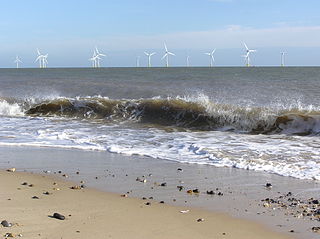
The Scroby Sands Wind Farm is a wind farm located on the Scroby Sands sandbank in the North Sea, 2.5 kilometres (1.6 mi) off the coast of Great Yarmouth in eastern England, United Kingdom. It was commissioned in March 2004 by Powergen Renewables Offshore, a division of E.ON UK. It has a nameplate capacity of 60 megawatts and is able to produce power to supply 41,000 households. Between 2005 and 2010, its capacity factor was between 26 and 32%. Its levelised cost has been estimated at £105/MWh.

The United Kingdom is the best location for wind power in Europe and one of the best in the world. The combination of long coastline, shallow water and strong winds make offshore wind unusually effective.

Greater Gabbard is a 504 MW wind farm, built on sandbanks 23 kilometres (14 mi) off the coast of Suffolk in England at a cost of £1.5 billion. It was completed on 7 September 2012 with all of the Siemens SWT3.6–107 turbines connected. Developed as a joint venture between Airtricity and Fluor, it is now jointly owned by SSE Renewables and Innogy.

Offshore Windpark Egmond aan Zee (OWEZ) is an offshore wind farm in the Dutch part of the North Sea, located approximately 10 km from the coast near Egmond aan Zee. It was the first large-scale offshore wind farm to be built off the Dutch North Sea coast. The wind farm was built by NoordzeeWind, a joint venture consisting of Shell and Nuon.
Atlantic Array was a proposed offshore wind farm in the Bristol Channel, off the coast of North Devon and South Wales, United Kingdom. It was a development by RWE Npower Renewables. With a planned 1.2 gigawatt capacity, it would have been one of the world's largest offshore wind farms. The project was cancelled in November 2013.
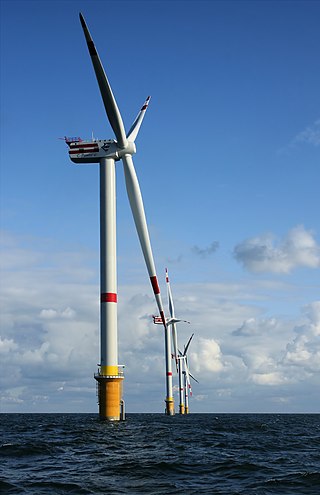
The Thorntonbank Wind Farm is an offshore wind farm, 30 km (19 mi) off the Belgian coast, in water ranging from 12 to 27 metres deep. It is the first offshore wind farm in Belgium.
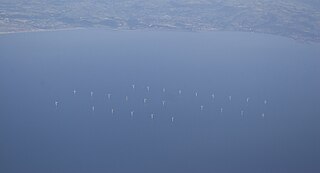
Rhyl Flats Offshore Wind Farm is a 25 turbine wind farm approximately 8 km north east of Llandudno in North Wales. It is Wales' second offshore wind farm and the third offshore wind farm to be built within Liverpool Bay. It has a maximum rated output of 90 MW.
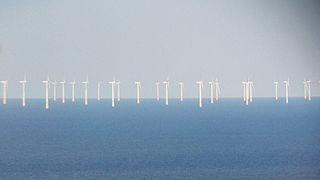
Gwynt y Môr is a 576-megawatt (MW) offshore wind farm located off the coast of Wales and is the fifth largest operating offshore windfarm in the world. The farm has 160 wind turbines of 150 metres (490 ft) tip height above mean sea level.

The Burbo Bank Offshore Wind Farm is a 348 MW offshore wind farm located on the Burbo Flats in Liverpool Bay on the west coast of the UK in the Irish Sea. It consists of an original 90 MW wind farm commissioned in 2007 and a 258 MW extension completed in 2017.

The Kentish Flats Offshore Wind Farm is a wind farm located off the coast of Kent, England on a large, flat and shallow plateau just outside the main Thames shipping lanes. The wind farm is operated by Vattenfall.

Innogy Nordsee 1-2-3 is a proposal for a large wind farm complex off Germany's coast. The planned offshore installation is to be built 40 kilometres (25 mi) north of the island of Juist, within an area of around 100 square kilometres (39 sq mi) and in water 26–34 metres (85–112 ft) deep. The project includes three wind farms: Innogy Nordsee 1 with 54 turbines, Innogy Nordsee 2 with 48 turbines, and Innogy Nordsee 3 with 60 turbines. In total, 162 wind turbines with a capacity of 6.15 megawatts (MW) will be used.

The Lynn and Inner Dowsing wind farms are a pair of round 1 wind farms located in the North Sea, in the shallow waters at the entrance to The Wash off the coast of Lincolnshire, England. The wind farms were developed as a single unit after planning consent was given in 2003. Construction work began in 2006 and was completed in 2009.

The Ormonde Wind Farm is a wind farm west of Barrow-in-Furness in the Irish Sea. The wind farm covers an area of 8.7 square kilometres (3.4 sq mi). It has a total capacity of 150 MW and is expected to produce around 500 GWh of electricity per year.
Triton Knoll Wind Farm is an 857 MW round 2 offshore wind farm nearing completion 33 kilometres (21 mi) off the coast of Lincolnshire, in the North Sea, England.

Humber Gateway Wind Farm is an offshore wind farm 8 kilometres (5 mi) east of Spurn Point off the coast of North East Lincolnshire, in the North Sea, England; the wind farm is located in water depths around 15 metres (49 ft) and covers an area of approximately 25 square kilometres (9.7 sq mi). The wind farm became operational in June 2015.
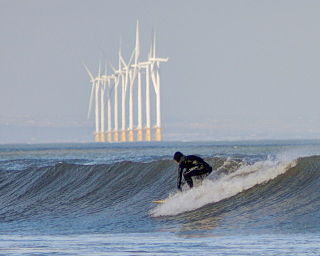
Teesside Wind Farm, or alternatively referred to as Redcar Wind Farm, is a 27 turbine 62 MW capacity offshore wind farm constructed just to the east of the mouth of the River Tees and 1.5 km north of Redcar off the North Yorkshire coast, in the North Sea, England.

Rampion is an offshore wind farm developed by E.ON, now operated by RWE, off the Sussex coast in the UK. The wind farm has a capacity of 400 MW. The wind farm was commissioned in April 2018 and was the first offshore wind farm for the whole south coast of England.
Dogger Bank Wind Farm is a group of offshore wind farms under construction 130 to 200 kilometres off the east coast of Yorkshire, England in the North Sea. It is considered to be the world's largest offshore windfarm. It was developed by the Forewind consortium, with three phases envisioned - first phase, second phase and third phase. In 2015 the third phase was abandoned, while the first and second phases were granted consent. It was initially expected that the Dogger Bank development will consist of four offshore wind farms, each with a capacity of up to 1.2 GW, creating a combined capacity of 4.8 GW. As of 2023, a total of 277 turbines are expected to be built and produce a capacity of 3.6 GW, enough to power 6 million homes.


















